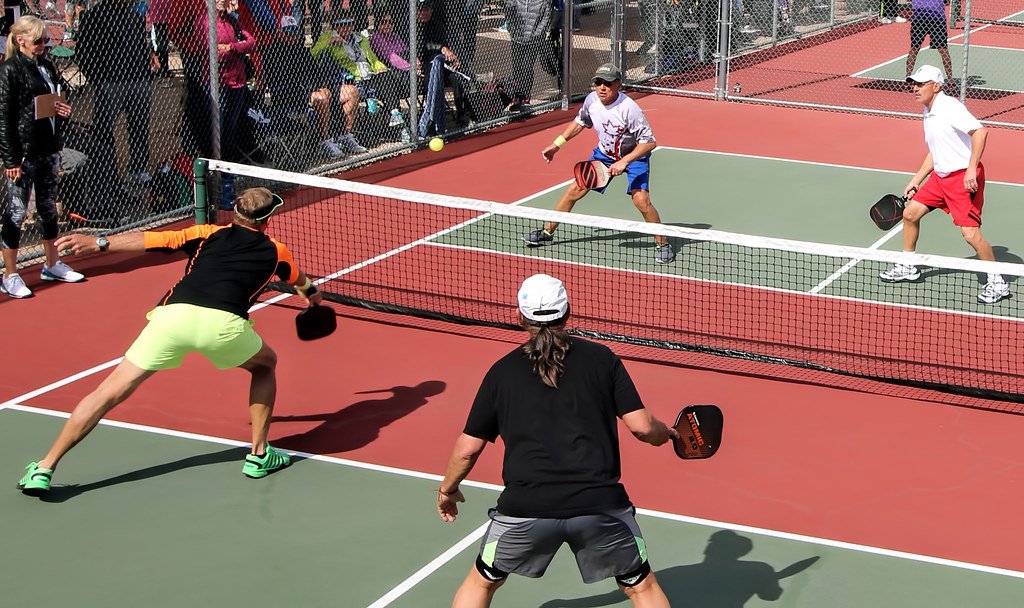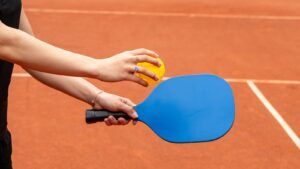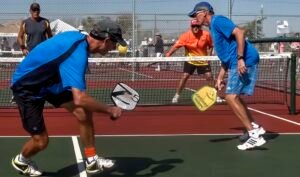As the morning dew evaporates from the outdoor pickleball courts, athletes clad in vibrant jerseys prepare to embark on a riveting battle of agility, strategy, and unwavering determination. The allure of competitive pickleball beckons players from across the globe to flaunt their skills, showcasing their finesse amidst the fiercely contested matches. However, behind this exhilarating spectacle lies an often-overlooked aspect—the financial investment required to fuel this passion for the sport. From registration fees and travel expenses to equipment upgrades, the world of competitive pickleball demands a thoughtful budgeting approach. In this article, we delve into the realm of tournament expenditure, unraveling the niche nuances of how dedicated players balance their love for the game with the associated costs. So, lace up your sneakers and join us as we explore the compelling world of “The Cost of Competitive Pickleball: Budgeting for Tournaments.
Table of Contents
- Understanding the Financial Investment Required for Competitive Pickleball
- Factors to Consider when Budgeting for Pickleball Tournaments
- Analyzing Tournament Fees and Expenses: A Comprehensive Breakdown
- Tips and Strategies to Minimize Costs and Maximize Value in Competitive Pickleball
- Developing a Sustainable Budgeting Plan for Competitive Pickleball Tournaments
- Q&A
- The Conclusion

Understanding the Financial Investment Required for Competitive Pickleball
One of the key aspects to consider when diving into the world of competitive pickleball is understanding the financial investment involved. While pickleball is generally known for being a relatively affordable sport, the expenses can add up when you aim to compete at a higher level.
Equipment plays a crucial role in this sport, and having the right gear can make a significant difference in your performance. This includes a high-quality paddle, pickleballs, proper court shoes, and possibly even specialized apparel. Depending on your skill level and personal preferences, paddle prices can range anywhere from $50 to $200, while footwear can vary from $80 to $150. It’s worth investing in durable equipment to ensure longevity and enhanced gameplay.
In addition to equipment, there may be registration fees for tournaments and leagues. These costs can vary depending on the level of competition and location. It’s recommended to research and plan accordingly to set aside funds for these events. Furthermore, travel and accommodation expenses may arise if you decide to participate in tournaments outside of your local area.
To further improve your skills and gain a competitive edge, you may consider investing in coaching or attending clinics and workshops. These opportunities provide invaluable guidance and allow you to learn from experienced players. Coaching fees can range between $50 to $150 per session, while clinics or workshops may have a set fee or charge based on the duration and content provided.
Ultimately, is essential for setting realistic goals and budgeting effectively. By carefully considering the costs associated with equipment, tournaments, coaching, and other related expenses, you can fully immerse yourself in this exhilarating sport and take your pickleball journey to new heights. So, embrace the financial aspects while enjoying the thrill of competitive pickleball – where skill, strategy, and a little bit of financial planning lead to success!
Factors to Consider when Budgeting for Pickleball Tournaments
When it comes to planning and budgeting for pickleball tournaments, there are several important factors to consider. These factors will help ensure the success of the event and create an enjoyable experience for all participants.
1. Venue and Facilities: The choice of venue is crucial in determining the overall cost and experience of the tournament. Consider factors such as court availability, lighting, seating capacity, and parking facilities. It is crucial to have ample space for players, spectators, and vendors. Research potential venues and compare their prices and amenities before making a final decision.
2. Equipment and Supplies: Pickleball tournaments require various equipment and supplies for smooth operations. This can include pickleball nets, balls, paddles, scoreboards, first aid kits, and refreshments. Consider whether you will need to purchase or rent these items and factor their costs into the budget. Additionally, ensure that you have a system in place to track and manage equipment inventory, as replacements may be necessary during the tournament.
3. Marketing and Promotion: Proper marketing and promotion are essential to attract participants and spectators to the tournament. Consider allocating a portion of the budget for advertising, online registration platforms, signage, social media campaigns, and website development. Collaborate with local sports organizations, pickleball clubs, and influencers to help spread the word and generate excitement about the tournament.
4. Staffing and Volunteers: A well-organized tournament requires a dedicated team of staff members and volunteers. Determine the number of individuals required for roles such as tournament directors, referees, scorekeepers, and event coordinators. If possible, enlist volunteers from the pickleball community to help reduce costs. Make sure to allocate funds for staff payment or volunteer appreciation gestures, such as certificates or small tokens of appreciation.
By considering these factors when budgeting for pickleball tournaments, you can ensure a successful and memorable event for all participants.
Analyzing Tournament Fees and Expenses: A Comprehensive Breakdown
Participating in tournaments can be an exciting experience for both amateur and professional athletes. However, it’s important to understand the financial aspects that come along with these events. In this section, we will dive deep into the various fees and expenses associated with tournaments, providing a comprehensive breakdown to help you plan your participation effectively.
1. Registration Fees:
One of the primary costs you’ll encounter when signing up for a tournament is the registration fee. This fee is typically non-refundable and may vary depending on the level of competition, the size of the event, and the sport involved. It’s crucial to read the tournament guidelines carefully to determine how much you need to budget for registration.
2. Accommodation and Travel:
Attending out-of-town tournaments often involves additional expenses such as accommodation and travel. These costs can quickly add up, so it’s essential to factor them into your overall budget. Look for discounted rates on hotels or explore options for sharing accommodations with fellow participants to reduce costs. Additionally, consider transportation expenses like flights, car rentals, or fuel costs and plan accordingly.
3. Equipment and Uniforms:
Depending on the nature of the tournament, you may need specific equipment or uniforms that comply with regulations. Include these costs in your analysis to ensure you’re adequately prepared. It’s wise to check if any equipment can be rented or borrowed, saving you the expense of purchasing items that you might not need again in the future.
4. Food and Entertainment:
While not a direct tournament expense, it’s important to consider the costs of food and entertainment during your participation. Tournaments can often be day-long events, and you’ll need to fuel yourself adequately. Plan for meals, snacks, and drinks, while also keeping in mind if you’d like to explore any local attractions or enjoy some downtime with your team after the intense competition.
In conclusion, analyzing tournament fees and expenses is a crucial step in planning your participation. By understanding the breakdown of costs such as registration fees, accommodation and travel, equipment and uniforms, and food and entertainment, you can create a comprehensive budget that allows you to focus on the game itself without any financial surprises along the way.
Tips and Strategies to Minimize Costs and Maximize Value in Competitive Pickleball
When it comes to competitive pickleball, it’s important to find ways to minimize costs without sacrificing the value of your game. Here are some tips and strategies that can help you make the most out of your pickleball experience:
- Invest in quality equipment: While it may be tempting to go for the cheaper options, investing in high-quality paddle and pickleballs can actually save you money in the long run. This is because durable equipment will last longer, reducing the need for frequent replacements.
- Practice proper shot selection: In competitive pickleball, every shot counts. By practicing and perfecting your shot selection, you can minimize unnecessary errors and maximize the value of each shot. Focus on accuracy and placement rather than relying solely on power.
- Consider carpooling or ride-sharing: If you participate in tournaments or frequently travel to play pickleball, carpooling or ride-sharing with fellow players can significantly reduce transportation costs. Not only does it save money on fuel expenses, but it also promotes a sense of community among players.
- Take advantage of free or low-cost practice courts: Many community centers, parks, and recreational facilities offer free or low-cost pickleball courts. Take advantage of these opportunities to practice and improve your skills without having to invest in expensive memberships or court fees.
- Utilize online resources and tutorials: The internet is a treasure trove of pickleball resources. From instructional videos to strategy guides, you can find a wealth of information online that can help you refine your game without spending a fortune on private lessons.
By implementing these tips and strategies, you can keep your pickleball costs in check while maximizing the value you receive from your competitive play. Remember, while it’s important to be mindful of expenses, always prioritize the joy and fulfillment that pickleball brings to your life.
Developing a Sustainable Budgeting Plan for Competitive Pickleball Tournaments
Hosting a successful pickleball tournament requires more than just skilled players and a well-maintained court. It also demands a well-thought-out budgeting plan that ensures all expenses are covered and allows for future growth. Here are some key steps to develop a sustainable budgeting plan for competitive pickleball tournaments:
- Identify Tournament Goals: Start by outlining your tournament’s goals and objectives. Determine whether you aim to attract professional players, promote the sport locally, or raise funds for a cause. Defining your goals will help you decide how much to allocate to various aspects, such as player prizes, venue expenses, marketing, and community outreach.
- Categorize Your Expenses: Once you’ve established your goals, categorize your expenses to ensure comprehensive coverage. Common categories include personnel costs (referees, event staff), court rental fees, equipment purchases or rentals, advertising and promotion, medical services, and administrative expenses.
- Create a Detailed Budget: With your expenses categorized, it’s time to create a detailed budget that will guide your financial decisions. Allocate specific amounts for each category, ensuring that you have a buffer for unexpected costs. Additionally, consider revenue streams, such as player registration fees, sponsorships, and concession sales, to offset your expenses.
By following these steps, you can establish a sustainable budgeting plan that allows your pickleball tournament to thrive. Remember to regularly review and adjust your budget as necessary to ensure financial stability and a successful event.
Q&A
What is the cost of participating in competitive pickleball tournaments?
The cost of participating in competitive pickleball tournaments can vary greatly depending on several factors such as entry fees, travel expenses, accommodation, and meals. It is important to budget accordingly to ensure you can cover all these costs while participating in tournaments.
How much are the average entry fees for pickleball tournaments?
The average entry fees for pickleball tournaments typically range from $30 to $100 per player, depending on the level of competition and the prestige of the event.
What should I consider when budgeting for travel expenses?
When budgeting for travel expenses, consider the distance you need to travel, mode of transportation, and the cost of gas or plane tickets. Additionally, factor in expenses such as rental cars, parking fees, and tolls.
What are the typical costs associated with accommodation during tournaments?
Accommodation costs can vary depending on the location and duration of the tournament. It is advisable to estimate costs for hotel rooms, Airbnb rentals, or camping fees, and also consider sharing accommodations with other players to reduce costs.
How much should I budget for meals during a tournament?
Budgeting for meals during a tournament depends on personal preferences and the availability of food options. A good estimate is to allocate $30 to $50 per day for meals, considering breakfast, lunch, dinner, and snacks.
Are there any additional costs to consider?
In addition to the main expenses mentioned earlier, participants should also consider costs for pickleball equipment and accessories, such as paddles, balls, grips, and clothing. It is also wise to set aside some funds for unforeseen circumstances or emergencies.
Are there any ways to reduce the costs of participating in competitive pickleball tournaments?
There are several strategies to reduce costs, such as carpooling with fellow players to share travel expenses, opting for more affordable accommodation options, and preparing meals in advance rather than eating out. Additionally, sponsors or fundraising initiatives can help offset some of the costs.
The Conclusion
As the echo of the final whistle fades away and the competitive fire simmers down, it’s time to reflect on the exhilarating world of competitive pickleball and the financial strides it demands. We hope this journey through the labyrinth of tournament expenses has equipped you with valuable insights and practical tips to navigate the labyrinthine landscape of budgeting.
In the captivating realm of competitive pickleball, where paddle meets ball and dreams intertwine, one must tread carefully, mindful of the financial implications that accompany a desire to conquer the court. From the humble beginnings of entry fees and transportation costs to more intricate considerations like accommodation and equipment, the road to tournament success can be paved with unexpected financial challenges.
But fear not, weary pickleball warrior, for armed with knowledge and prudence, you can conquer any fiscal trial on the path to glory. Remember, budgeting is not simply a stingy exercise in pinching pennies; rather, it is a dance between necessity and indulgence, striking a harmonious balance that allows you to pursue your passion while keeping your financial fortress intact.
Consider the tournament entry fees as an investment, a stepping stone towards honing your skills while rubbing shoulders with fellow pickleball enthusiasts. Choose your battles wisely, assessing the significance of each tournament, its prestige, and its potential impact on your long-term growth as a player. Embrace the thrill of competition, but do so with a discerning eye, mindful of the financial impact each decision may have on your pocket.
Transportation, the vessel that carries your pickleball dreams from one court to another, demands equal attention. Seek out the most cost-effective options, channeling your inner explorer in the pursuit of discounted flights, carpooling opportunities, or even the occasional scenic train ride. Remember, a frugal journey doesn’t mean sacrificing comfort. Rather, it is an opportunity to indulge in both practicality and adventure.
Ah, accommodation, the sanctuary that welcomes you after a day of intense battles and blistering forehands. Navigate the labyrinth of hotel rates and Airbnb options, seeking the perfect balance between comfort and budget. Embrace the camaraderie of fellow competitors, opting for shared accommodations or an impromptu pickleball slumber party to lighten the financial burden while forging lifelong bonds.
And let us not forget the crux of our beloved sport – the equipment. The tantalizing paddle, the all-important balls, and the humble court shoes that guide us through every thrilling rally. Here, striking a balance becomes an art, as we seek performance without straining our financial mettle. Keep an eye out for discounts and sales, and don’t shy away from seeking guidance from seasoned pickleball veterans who have mastered the delicate art of equipment procurement.
As the curtain falls on this enlightening expedition into the cost of competitive pickleball, we hope you emerge equipped with the tools to navigate the financial battlefield that lies before you. Remember, budgeting is not the enemy; it is your ally, guiding your pickleball odyssey with prudence and precision. So go forth, valiant player, and conquer the courts with the awareness that behind every step on the path to victory lies a carefully calculated financial stride.
As an affiliate, my content may feature links to products I personally use and recommend. By taking action, like subscribing or making a purchase, you’ll be supporting my work and fueling my taco cravings at the same time. Win-win, right?
Want to read more? Check out our Affiliate Disclosure page.




